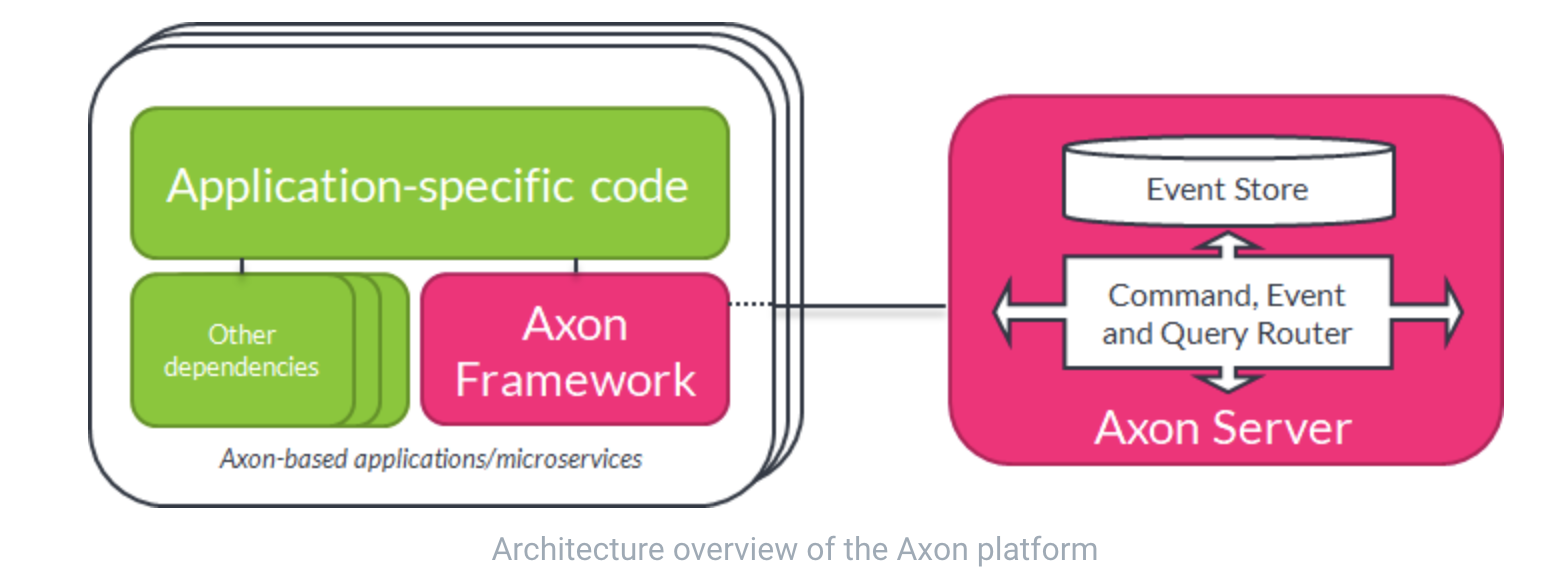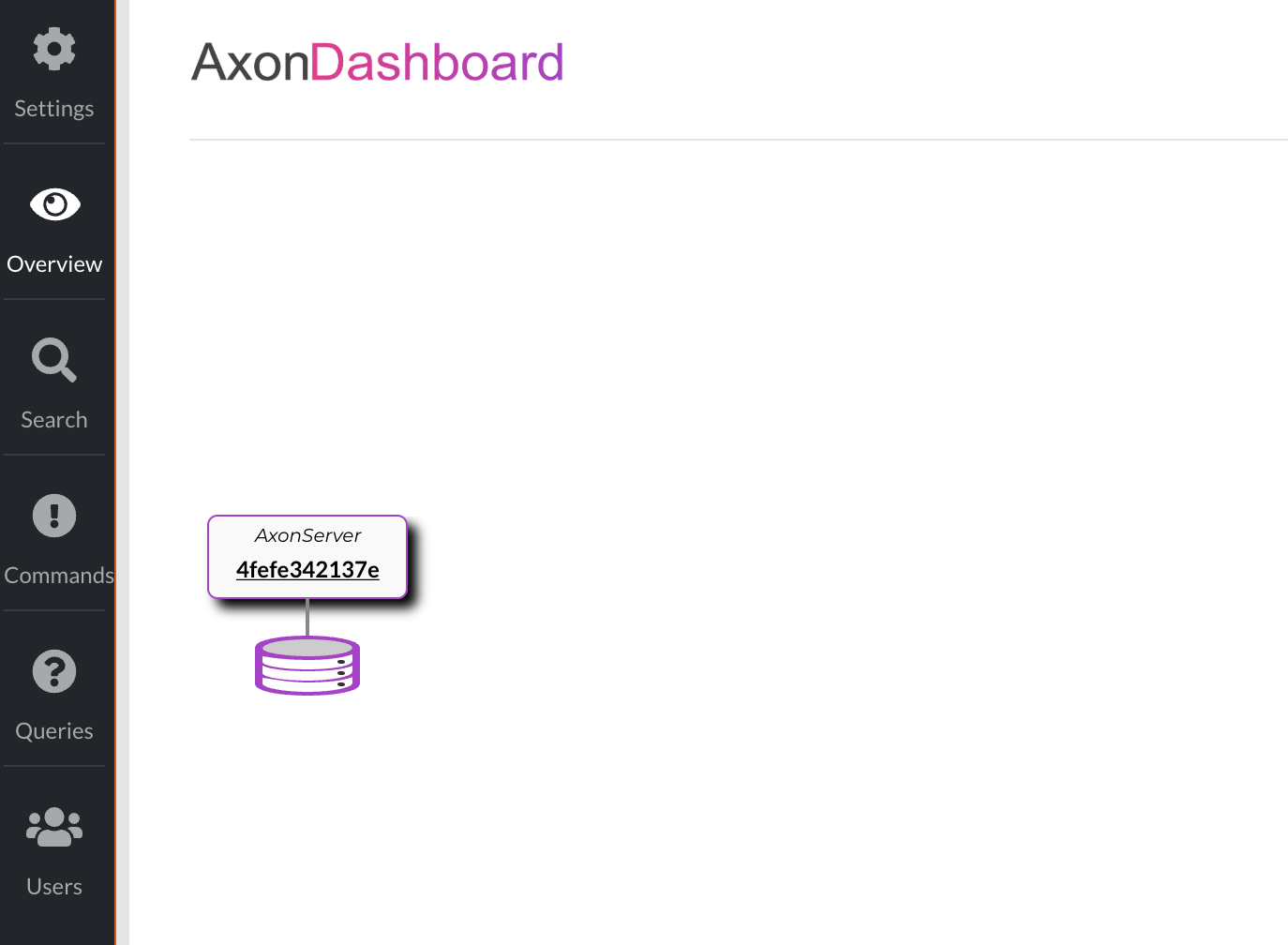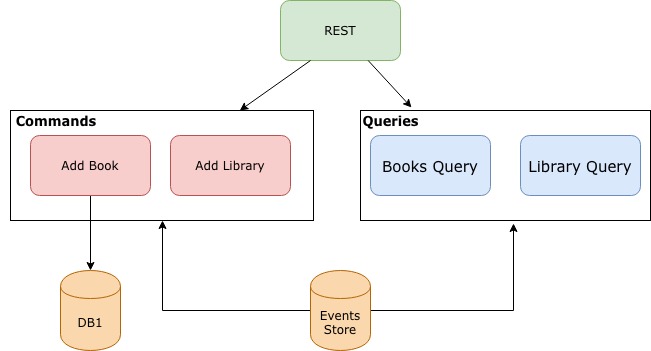Axon - CQRS with Spring Boot by examples
We already introduced CQRS architectures a while ago here. The focus was to migrate a legacy monolith application into a CQRS architecture. However, we didn’t go in deep by actually coding it. Let’s do this using Axon Framework and Spring Boot. We’ll create a library application from scratch.
Some Concepts First
Axon is not just a framework, but an infrastructure that also involves an Axon server. The Axon server manages a bus event and all the mecanisms to manage the commands and queries:

This image is taken from the official Axon documentation for version 4.
Event Store
Where all our events will be stored? In the Event Store running under the Axon Server (see AxonServerEventStore.java for more information). If we want to use an embedded event store in, let’s say, a RDBMS instance or in Mongo, Axon provides custom implementations for this. More in here. This is something we’ll like to explore further in the future.
Aggregates
Aggregates are the domain objects in Axon. We can configure our configuration to match the aggregate to an entity in our database.
When we connect our application, Events will be read on-demand when an existing aggregate is targeted by a command. To enhance efficiency when processing multiple commands to the same aggregate, Axon supports caching repositories that would keep the aggregate in memory to avoid another read of the same events. Once aggregates are totally synchronized, it will be ready to be used. See AggregateLifecycle.java.
Getting Started
Run Axon Server
We’ll use the official docker image to startup an Axon server instance:
docker run -d --name axonserver -p 8024:8024 -p 8124:8124 axoniq/axonserver
Feel free to startup a server instance yourself by downloading the binaries from here.
In order to check the installation was succeded, browse to “http://localhost:8024/” and we should see the Axon dashboard:

Axon Framework: Maven Dependencies
We’ll use the Axon Spring Boot Starter maven dependency in the pom.xml for all our projects:
<dependency>
<groupId>org.axonframework</groupId>
<artifactId>axon-spring-boot-starter</artifactId>
<version>4.0</version>
</dependency>
<dependency>
<groupId>org.springframework.boot</groupId>
<artifactId>spring-boot-starter-web</artifactId>
<version>2.0.6.RELEASE</version>
</dependency>
This is the easiest way to get warm with Axon. Spring Boot eases the configuration using default components in Axon. For more information, go to here.
Also, Axon provides a very good tutorial or recipe with Spring Boot.
The Library Application
Let’s start coding! We’ll write a library application where we can organize books into different libraries.

We need to start thinking on events. What is a library? In object oriented programming, a library is just a set of books. In event oriented programming, a library is:
- event 1: library named “My Library”
- event 2: Added book “x” to “My Library”
- event 3: Added book “y” to “My Library”
Note, we can redefine the concept of libraries anytime by adding a new event. And the most important, we have a time-scale of our library thanks to events.
On the other hand, we have the commands. A command is an use case in our application and it can derivate in a set of events that will define the current state.
Therefore, let’s continue coding our application.
Application: Spring Boot
We’ll use Spring Boot which is the easiest way to startup our application:
@SpringBootApplication
public class Application {
public static void main(String[] args) {
SpringApplication.run(Application.class, args);
}
}
This is only for testing purposes. For production, we’d need to provide a persistence state of the event store and use a distributed queue. We’ll write about these refinements in a future post.
Commands: Use Cases
The commands are the use cases of our application and needs to verify the data is correct before adding an event. Therefore, we don’t need to validate the events afterwards.
- Register a Library
Let’s define the command to register a new library:
public class RegisterLibraryCommand {
@TargetAggregateIdentifier
private final Integer libraryId;
private final String name;
// Constructor and getters
}
We’ll identify our libraries by an integer and a name.
Let’s start writing the Library aggregate:
@Aggregate
public class Library {
@AggregateIdentifier
private Integer libraryId;
private String name;
private List<String> isbnBooks;
protected Library() {
// For Axon instantiation
}
@CommandHandler
public Library(RegisterLibraryCommand cmd) {
Assert.notNull(cmd.getLibraryId(), "ID should not be null");
Assert.notNull(cmd.getName(), "Name should not be null");
AggregateLifecycle.apply(new LibraryCreatedEvent(cmd.getLibraryId(), cmd.getName()));
}
// getters
}
Axon Spring Boot starter will scan for classes annotated with @Aggregate and register it into the Axon application. The same for methods annotated with @CommandHandler where the Axon framework will invoke them after trigger a command of the matching type.
The constructor with the RegisterLibraryCommand command states the aggregate will be created using this command. This can be also achieved via:
AggregateLifecycle.createNew(Library.class, Library::new);
The other protected constructor is used by Axon to instantiate existing aggregates from events.
And as we already said, the events define the state of the aggregates, so we need to register this creation with a new event:
public class BookCreatedEvent {
@TargetAggregateIdentifier
private final Integer libraryId;
private final String isbn;
private final String title;
// constructor and getters
}
Hold on… Something is missing… where are we setting the library data? Not in the command handler: we need to validate the data in the commands, but we should not set the data here. Why? As we already said, after our application started and joined to the Axon server, it will synchronize the events in the server and create the required aggregates. Therefore, we need to set the data when handling the events:
@Aggregate
public class Library {
@AggregateIdentifier
private Integer libraryId;
private String name;
private List<String> isbnBooks;
protected Library() {
// For Axon instantiation
}
@CommandHandler
public Library(RegisterLibraryCommand cmd) {
Assert.notNull(cmd.getLibraryId(), "ID should not be null");
Assert.notNull(cmd.getName(), "Name should not be null");
AggregateLifecycle.apply(new LibraryCreatedEvent(cmd.getLibraryId(), cmd.getName()));
}
// getters
@EventSourcingHandler
private void handleCreatedEvent(LibraryCreatedEvent event) {
libraryId = event.getLibraryId();
name = event.getName();
isbnBooks = new ArrayList<>();
}
}
We annotate the methods with @EventSourcingHandler to listen events of a concrete type and that manipulate the aggregates. Don’t confuse with the annotation @EventHandler which is used outside of an aggregate class. We’ll see an example later.
- Register a Book
“I want to add a new book to my library”. Let’s write this command:
public class RegisterBookCommand {
@TargetAggregateIdentifier
private final Integer libraryId;
private final String isbn;
private final String title;
// constructor and getters
}
And let’s update our aggregate:
@Aggregate
public class Library {
@AggregateIdentifier
private Integer libraryId;
private String name;
private List<String> isbnBooks;
// constructors
// getters
// handleCreatedEvent command
@CommandHandler
public void addBook(RegisterBookCommand cmd) {
Assert.notNull(cmd.getLibraryId(), "ID should not be null");
Assert.notNull(cmd.getIsbn(), "Book ISBN should not be null");
AggregateLifecycle.apply(new BookCreatedEvent(cmd.getLibraryId(), cmd.getIsbn(), cmd.getTitle()));
}
@EventSourcingHandler
private void addBook(BookCreatedEvent event) {
isbnBooks.add(event.getIsbn());
}
}
Where BookCreatedEvent class is:
public class BookCreatedEvent {
@TargetAggregateIdentifier
private final Integer libraryId;
private final String isbn;
private final String title;
// constructor and getters
}
Nothing new so far, but wait a second: we’re only using the ISBN book identifier in the aggregate, so we’re losing the title! Kind of. This is because we wanted to use another repository to store the book data by listening to the BookCreatedEvent event outside of the aggregate.
We’ll use a JPA repository and H2 as an in-memory database. The only thing we need to add is to add these two maven dependencies:
<dependency>
<groupId>org.springframework.boot</groupId>
<artifactId>spring-boot-starter-data-jpa</artifactId>
<version>2.0.6.RELEASE</version>
</dependency>
<dependency>
<groupId>com.h2database</groupId>
<artifactId>h2</artifactId>
<version>1.4.197</version>
</dependency>
Then, create the repository using Spring Data:
@Repository
public interface BookRepository extends CrudRepository<BookEntity, String> {
List<BookEntity> findByLibraryId(Integer libraryId);
}
And finally, add a service to listen events using the @EventHandler annotation:
@Service
public class BookRepositoryProjector {
private final BookRepository bookRepository;
public BookRepositoryProjector(BookRepository bookRepository) {
this.bookRepository = bookRepository;
}
@EventHandler
public void addBook(BookCreatedEvent event) throws Exception {
BookEntity book = new BookEntity();
book.setIsbn(event.getIsbn());
book.setLibraryId(event.getLibraryId());
book.setTitle(event.getTitle());
bookRepository.save(book);
}
}
And that’s all!
Queries
We are done with the use cases and commands. We’ll work now about how to expose our data outside using the @QueryHandler annotation.
Important: @QueryHandler annotations do not work on aggregate classes.
- Query List of Books
If we own the repository where our data is stored, we could only read the data from the repository provided by Spring Data:
@Service
public class BookRepositoryProjector {
private final BookRepository bookRepository;
// constructor
// add book method
@QueryHandler
public List<BookBean> getBooks(GetBooksQuery query) {
return bookRepository.findByLibraryId(query.getLibraryId()).stream()
.map(e -> {
BookBean book = new BookBean();
book.setIsbn(e.getIsbn());
book.setTitle(e.getTitle());
return book;
}).collect(Collectors.toList());
}
}
Where the GetBooksQuery class is:
public class GetBooksQuery {
private final Integer libraryId;
// constructor and getter
}
- Get Library aggregate
However, most of the times we will want the current state of an aggregate since this would be the view of our business. We need to instantiate the Repository of the Event Store: where the aggregates are. Thanks to Spring, the correct implementation is already in the application context and all we need is:
@Service
public class LibraryProjector {
private final Repository<Library> libraryRepository;
public LibraryProjector(Repository<Library> libraryRepository) {
this.libraryRepository = libraryRepository;
}
@QueryHandler
public Library getLibrary(GetLibraryQuery query) throws InterruptedException, ExecutionException {
CompletableFuture<Library> future = new CompletableFuture<Library>();
libraryRepository.load("" + query.getLibraryId()).execute(future::complete);
return future.get();
}
}
Where the GetLibraryQuery class is:
public class GetLibraryQuery {
private final Integer libraryId;
// constructor and getter
}
Something odd is that the load method only accepts String for the aggregate identifiers and we use an integer. That’s why we needed to cast it to String.
REST layer
Right, we now know how to deal with command and queries, but how can we invoke or send these commands or events?
Axon provides a CommandGateway interface to trigger commands:
commandGateway.send(new MyCommand(...));
And it also provides a QueryGateway interface to trigger queries:
CompletableFuture<Library> future = queryGateway.query(new MyQuery(...), Library.class);
return future.get();
Therefore, this is how would look like our REST API:
@RestController
public class LibraryRestController {
private final CommandGateway commandGateway;
private final QueryGateway queryGateway;
@Autowired
public LibraryRestController(CommandGateway commandGateway, QueryGateway queryGateway) {
this.commandGateway = commandGateway;
this.queryGateway = queryGateway;
}
@PostMapping("/api/library")
public String addLibrary(@RequestBody LibraryBean library) {
commandGateway.send(new RegisterLibraryCommand(library.getLibraryId(), library.getName()));
return "Saved";
}
@GetMapping("/api/library/{library}")
public Library getLibrary(@PathVariable Integer library) throws InterruptedException, ExecutionException {
return queryGateway.query(new GetLibraryQuery(library), Library.class).get();
}
@PostMapping("/api/library/{library}/book")
public String addBook(@PathVariable Integer library, @RequestBody BookBean book) {
commandGateway.send(new RegisterBookCommand(library, book.getIsbn(), book.getTitle()),
LoggingCallback.INSTANCE);
return "Added";
}
@GetMapping("/api/library/{library}/book")
public List<BookBean> addBook(@PathVariable Integer library) throws InterruptedException, ExecutionException {
return queryGateway.query(new GetBooksQuery(library), ResponseTypes.multipleInstancesOf(BookBean.class)).get();
}
}
Run
We can run our application as an usual Spring Boot application. If you see the following in the output:
**********************************************
* *
* !!! UNABLE TO CONNECT TO AXON SERVER !!! *
* *
* Are you sure it's running? *
* If you haven't got Axon Server yet, visit *
* https://axoniq.io/download *
* *
**********************************************
This message means we cannot connect with the Axon server. Double check the Axon server is up and running and/or go to the Axon dashboard in the browser.
- Add a library:
POST: http://localhost:8080/api/library
BODY:
{
"libraryId": 1,
"name": "My Library"
}
- Add a book:
POST: http://localhost:8080/api/library/1/book
BODY:
{
"isbn":"123460",
"title": "My Title",
"author": "Jose Carvajal"
}
- Get books in a library:
GET: http://localhost:8080/api/library/1/book
- Get Library:
GET: http://localhost:8080/api/library/1
Conclusion
We have introduced some of the most important features in Axon and how Axon works. Axon Framework makes extremely easy to implement a CQRS architecture and is very well integrated to Spring and Spring Cloud (for doing the services discoverable). Also, Axon is VERY customisable. We can refine until the most tiny component in your architecture which demostrates what a well designed the framework is.
On the other side, even when the documentation is quite extensive and good, I would have appreciated working examples for version 4 of basic functionality. It does not help either when the Axon documentation redirects to the first chapter when you search something in google.
See my Github repository for a full example.
